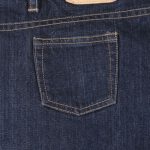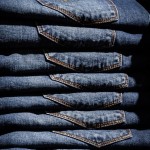Stretch jeans have become one of the most popular styles of jeans on the market. They feature a similar appearance as other jeans, but rather than being constructed entirely of denim, they are constructed of both denim and an elastic material. The presence of an elastic material allows the jeans to stretch without breaking, hence why they are known as “stretch jeans.” If you’re looking to purchase a new pair of stretch jeans, though, you’ll need to consider the amount of elastic material used in their construction.
The Basics of Stretch Jeans
Stretch jeans are made of a blend of multiple materials, specifically denim and an elastic material. All jeans, of course, contain denim. It’s a soft yet durable material consisting of cotton. Stretch jeans are made mostly of denim as well, but they contain a small amount of elastic material.
Without any elastic material, jeans offer little or no elasticity. You might be able to stretch them slightly by pulling or tugging on them, but regular jeans lack the elasticity of their stretch counterparts. As a result, many men and women prefer stretch jeans. They are still soft and durable, but they are able to stretch more than regular jeans thanks to the elastic material used in their construction.
Some of the most common elastic materials used in the construction of stretch jeans include the following:
- Lycra
- Polyester
- Spandex
Slight Stretch
Slight stretch jeans are characterized by a very small amount of elastic material. The slight stretch jeans sold here at MakeYourOwnJeans, for example, only have 0.5% elastic material used in their construction. The remaining 99.5% of their material consists of standard denim.
Just a half-percent of elastic material may sound insignificant, but it changes the physical properties of slight stretch jeans. You really have to feel them firsthand to experience the difference between regular and slight stretch jeans. With that said, slight stretch jeans offer a more form-fitting appearance that’s able to stretch with your body as you wear them. Of course, they aren’t as elastic as other types of stretch jeans (see below), but slight stretch jeans are still a popular choice because of the minimal amount of elastic material used in their construction.
Medium Stretch
There are also medium stretch jeans that, as the name suggests, contain a moderate amount of elastic material used in their construction. Medium stretch jeans offer a delicate between denim and elasticity. They are still made mostly of denim, but they contain a decent amount of an elastic material as well.
Some medium stretch jeans contain 1% elastic material, whereas others contain 2%. The former type are comprised of 99% denim, whereas the latter type are comprised of 98% denim. Regardless, medium stretch jeans typically contain around 1% to 2% elastic material.

High Stretch
High stretch jeans are characterized by a large amount of elastic material used in their construction. You’ll usually find them with about 3% elastic material. In other words, they contain up to six times more elastic material than slight stretch jeans.
When compared to slight and medium stretch jeans, high stretch jeans contain the most elastic material. As a result, they have some unique properties that aren’t found elsewhere. For starters, you’ll be able to stretch them more without damaging them. Many people will agree that high stretch jeans are also softer, and therefore more comfortable, than other types of jeans, including both stretch and non-stretch jeans.
Choosing the Right Amount of Elastic Material
So, should you choose slight, medium or high stretch jeans? If you’re unfamiliar with these three styles, it’s recommended that you try them all yourself to see which one meets or exceeds your expectations. Slight stretch jeans are prized for their minimal amount of elastic material. With only 0.5% of elastic material used in their construction, they share many similarities with regular jeans. With that said, they are still able to stretch — to some degree — without breaking.
Furthermore, light stretch jeans offer greater protection against washing-related damage than medium and high stretch jeans, allowing them to withstand the hands of time.
Medium stretch is perhaps the most popular style of stretch jeans. They contain two to four times more elastic material than slight stretch jeans. With their moderate or “medium” amount of elastic material, medium stretch jeans offer the best of both worlds. They are strong and rugged like regular jeans, yet they are also soft and elastic like stretch jeans.
If you want the greatest elasticity in your jeans, you’ll need to choose a pair of high stretch jeans. With a blend of 97% denim and 3% elastic material, they contain the most elastic material of all styles of stretch jeans. As a result, they can stretch the most. High stretch jeans almost feel like sweatpants. You can tug and pull on them without damaging them. They’ll simply stretch with your body while offering a more comfortable fit in the process.
The downside to high stretch jeans is that they are more susceptible to damage when washed and dried. You can still wash high stretch jeans, but you should follow the manufacturer’s instructions when doing so. You’ll typically find a care tag or label inside the waistband that contains instructions on how to clean and care for them. By following these instructions, your high stretch jeans will last for many years, all while offering an exceptional level of elasticity that’s not found in other types of stretch jeans.
In Conclusion
All stretch jeans are made of an elastic material, such as lycra, polyester or spandex. After all, that’s what distinguished them from regular jeans. Some stretch jeans, however, contain more elastic material than others. Slight stretch jeans have the least amount of elastic material at 0.5%, whereas high stretch jeans have the most elastic material at 3%. Finally, medium stretch jeans offer a balance between these two styles, with most types of medium stretch jeans featuring about 1% to 2% elastic material.











